Menu
Menu
Jaremi Picz b. February 26, 1955 in Lewin Brzeski. A Polish painter, sculptor and graphic artist honoured by the Minister of Culture and National Heritage with the Medal of Merit for Polish Culture. The creator of the Mała Polowa Objazdowa Gallery. The founder and owner of the proprietary Epicentrum ART Gallery in Opole.
On the path of his artistic career one can distinguish: cooperation with the Austrian PAKS Gallery in Vienna, Hubertendorf and Munich. Cooperation with Tablinum Management in Italy.
Among others participated in the following exhibitions: ART Carrousel Du Louvre in Paris, Joie de Vivre in Italy at Menaggio Lago Di Como, Société des Artistes Indépendants at the Grand Palais in Paris.
Jaremi is also a laureate of the International Caravaggio Award in Milan and a finalist of the international competition The Best Artist in the Field of Contemporary Art, Abstractionism and Sciarsism in Kiev. A member of the Association of Polish Artists and Designers – Warsaw Branch, a member of the Trade Union of Culture Creators – Warsaw Branch. A vice-president of the Association of Polish Artists and Designers in Opole.
In the years 1981-1982 he stayed in Germany, where he collaborated with the Polish Gallery of Wacław Suchecki in Düsseldorf. After returning to Poland, he made a bas-relief of the large entrance door to the Church of Saint Peter and Paul in Łubniany near Opole.
A participant and organizer of many plein-airs, exhibitions and other artistic events both in Poland and abroad.
His paintings are in galleries in Cracow, Warsaw, Gdańsk and are also put up for sale by larger auctions, including Agra-Art, Rempex and the Polish Auction House of Wojciech Śladowski in Cracow, Pra-Galeria and FacetoFace in Warsaw, Auctionshaus Wesser in Bremen.
ceives invitations to recognized art exhibitions every year.
Jaremi Picz b. February 26, 1955 in Lewin Brzeski. A Polish painter, sculptor and graphic artist honoured by the Minister of Culture and National Heritage with the Medal of Merit for Polish Culture. The creator of the Mała Polowa Objazdowa Gallery. The founder and owner of the proprietary Epicentrum ART Gallery in Opole.
On the path of his artistic career one can distinguish: cooperation with the Austrian PAKS Gallery in Vienna, Hubertendorf and Munich. Cooperation with Tablinum Management in Italy.
Among others participated in the following exhibitions: ART Carrousel Du Louvre in Paris, Joie de Vivre in Italy at Menaggio Lago Di Como, Société des Artistes Indépendants at the Grand Palais in Paris.
Jaremi is also a laureate of the International Caravaggio Award in Milan and a finalist of the international competition The Best Artist in the Field of Contemporary Art, Abstractionism and Sciarsism in Kiev. A member of the Association of Polish Artists and Designers – Warsaw Branch, a member of the Trade Union of Culture Creators – Warsaw Branch. A vice-president of the Association of Polish Artists and Designers in Opole.
In the years 1981-1982 he stayed in Germany, where he collaborated with the Polish Gallery of Wacław Suchecki in Düsseldorf. After returning to Poland, he made a bas-relief of the large entrance door to the Church of Saint Peter and Paul in Łubniany near Opole.
A participant and organizer of many plein-airs, exhibitions and other artistic events both in Poland and abroad.
His paintings are in galleries in Cracow, Warsaw, Gdańsk and are also put up for sale by larger auctions, including Agra-Art, Rempex and the Polish Auction House of Wojciech Śladowski in Cracow, Pra-Galeria and FacetoFace in Warsaw, Auctionshaus Wesser in Bremen.
Currently, he continues his artistic craft and receives invitations to recognized art exhibitions every year.
He was the organizer of many individual exhibitions and an active participant in many collective exhibitions, including:
He was the organizer of many individual exhibitions and an active participant in many collective exhibitions, including:
It took many years to conceive the idea of creating a series under the conventional title “Epicentre”.
Through various forms and slightly changing assumptions, appearing with the passage of time and the intensive process of creating my new artistic stage, this cycle has been changing its structure.
From the initial chaos symbolizing the cosmic disorder, to the extreme discipline of the form, assuming the shape of geometric symmetrical figures, the most perfect archetype of which is a circle.
The first assumption was to show the destruction and at the same time the transition from one form to another. The moment of the supernova explosion and the enormous energy released during this process. One could say by observing this phenomenon from a great distance – the beautiful death of a star.
Using the means of painting, I wish to show a phenomenon not only physical but also metaphysical. The symbolic display of the phenomenon of continuity and indissolubility of two elements – spirit and matter. The energy released during the explosion, scattering stardust in space, creating the seed of new life, new beings, is constant and is the driving force of all change.
My aspiration is to draw the viewer inside the painting by focusing their attention on its central point, so that they can feel the vibrations of energy and make them want to delve into and look no longer at the centre of the phenomenon, but at its epicentre.
It is about crossing the border between the material world and the world of feelings and intuition. The point is to think and feel deeper into what is just under the effective and violent process of destruction, to cause and effect. To the very meaning of changing life into death, and this, in turn, into another form of further existence. Therefore, my assumption is to focus not on the centre of the phenomenon, but rather – explicitly and unconditionally on its “EPICENTRE”. For what is the immediate cause of the change from one form to another. Looking at this point which is imperceptible and unconscious for the viewer, and which is the zone of the greatest concentration of energy. It reveals and symbolizes the whole sense of change and transformation – this Iconic Epicentre of limitless importance, is the subject of my creative experiments.
Inspiration with this philosophy resulted in the creation of a concept for the title of this comprehensive series.
It is also my intention to show how much energy can be released in a limited and simplest form, which is a circle. It would seem that a geometric figure is a stable, unshakable form, limited by its edges, unambiguously outlined. However, each figure, through its marking, is detached from the ground and someone’s will from which it was created, what also resulted in a certain charge of energy. Filling this form with colour, further intensifies this energy. Adding paint to this directional position builds up the tension and makes the assumed geometric figure, strictly defined, unshakable to live its own life.
It causes that the boundaries of this figure are no longer clearly defined and merge again with the surroundings from which it was created. It is like trying to show the pulsating transition of forms. I used here the assumptions and philosophy of the precursor of modern art and the founder of the trend known as Suprematism by Kazimierz Malewicz. Limiting the surface to geometric figures filled with colour. The most outstanding example of this is his Black Square, setting new directions and opening new fields of exploration, which constitute the foundation of a new philosophy of contemporary art.
The second idea for the technical construction of my paintings was inspired by the works of Jackson Pollock, where through a random, statistically unpredictable placement of paint on the canvas, he builds his own, despite everything, an extremely ordered world.
Another important assumption, on which the creation of my works of art is based, is to show the duality of nature. The human nature and nature in general. Just as there is good and evil, light and dark, spirit and matter, each of my paintings from the Quantum Epicentre series has two different faces. One of them is visible in a day light, but the other can only be seen when illuminated with ultraviolet light. In this case, the idea of creating the paintings was inspired by Planck’s philosophy, destroying the traditional theory of the wave structure of light radiation in favour of its quantum character. Or rather, an introduction to the physics of the concept of chaos theory. Hence the second part of the name of the series of my works, Quantum, which in a very simplified manner, could be called Radioactive Works.
Jaremi Picz
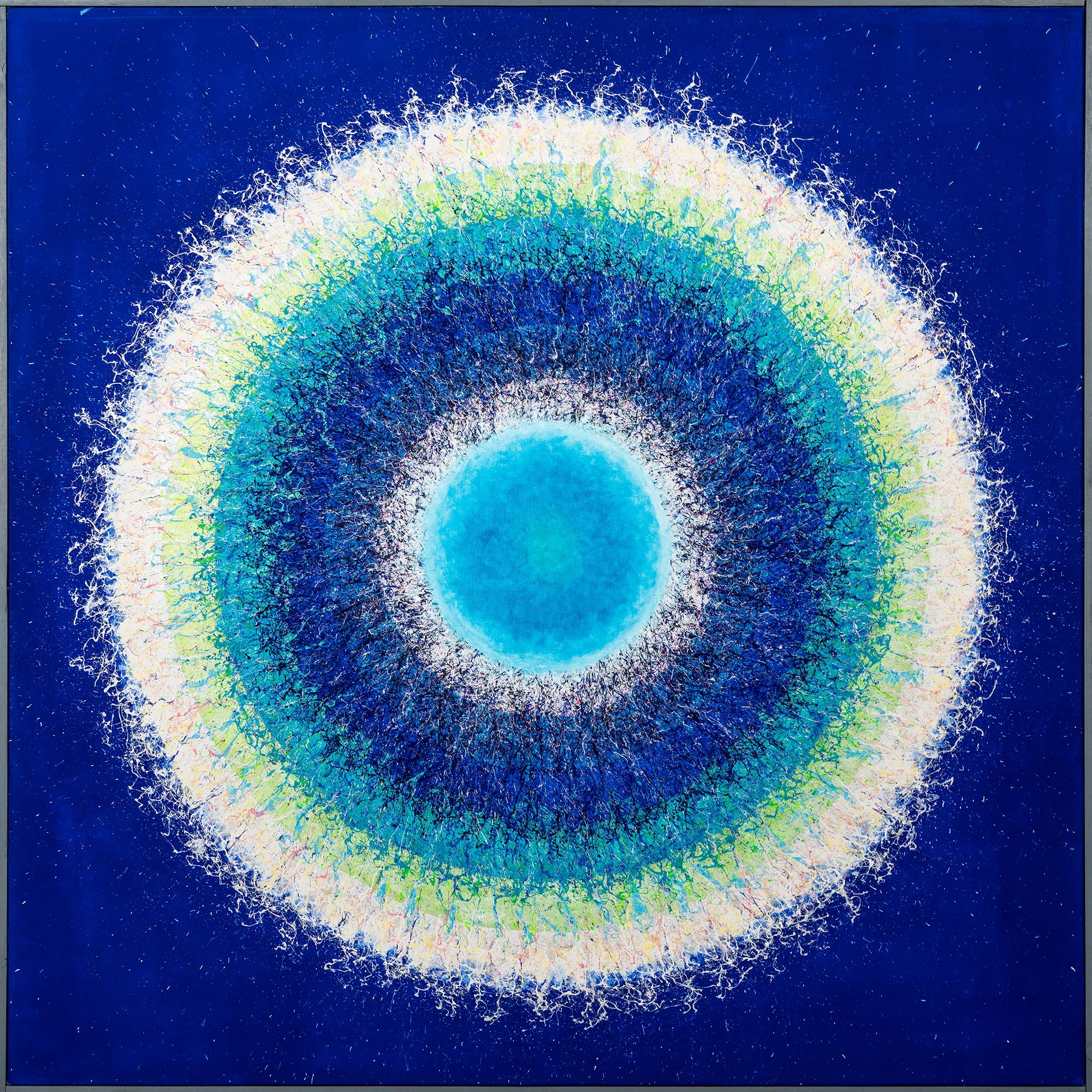
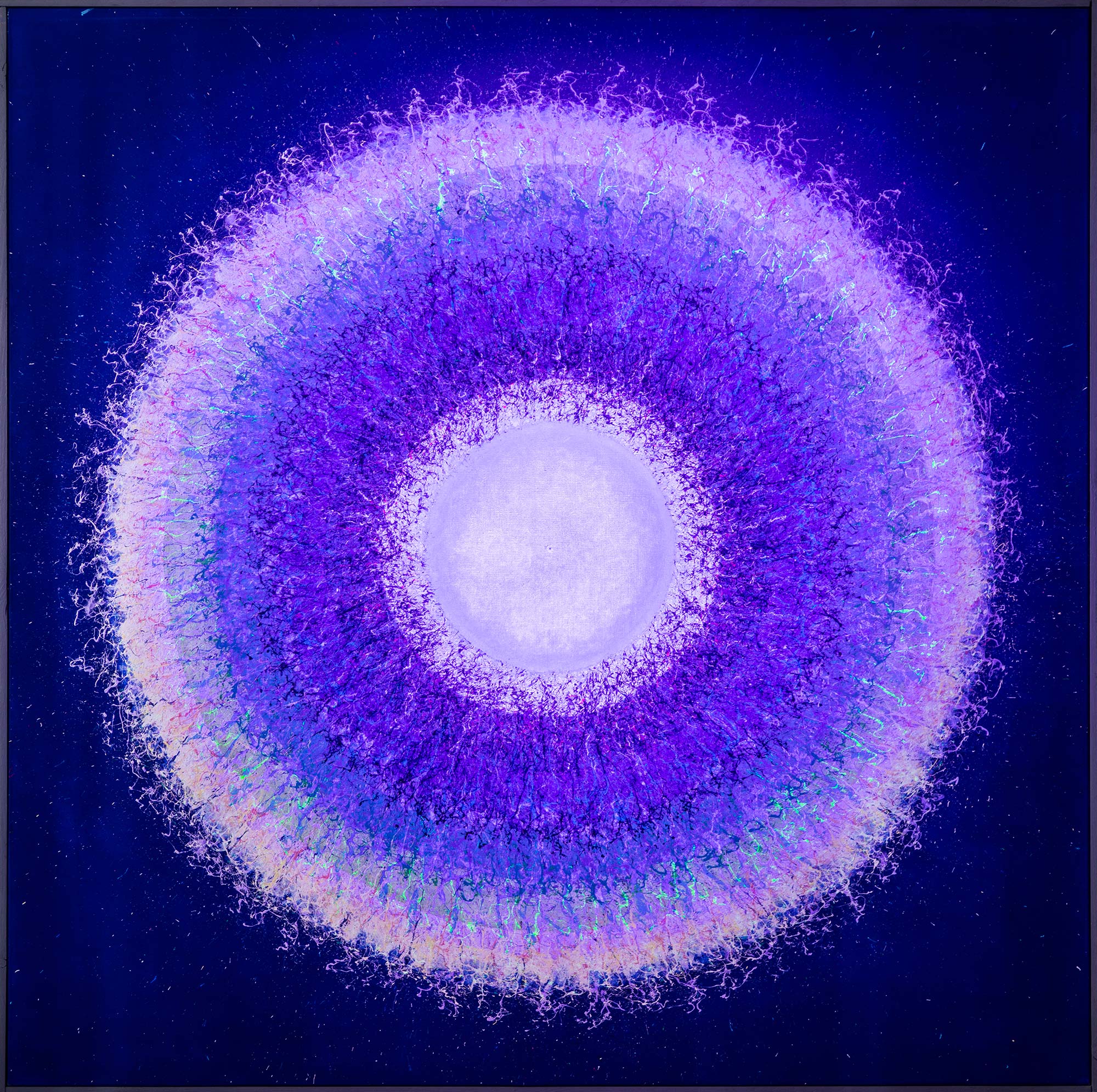
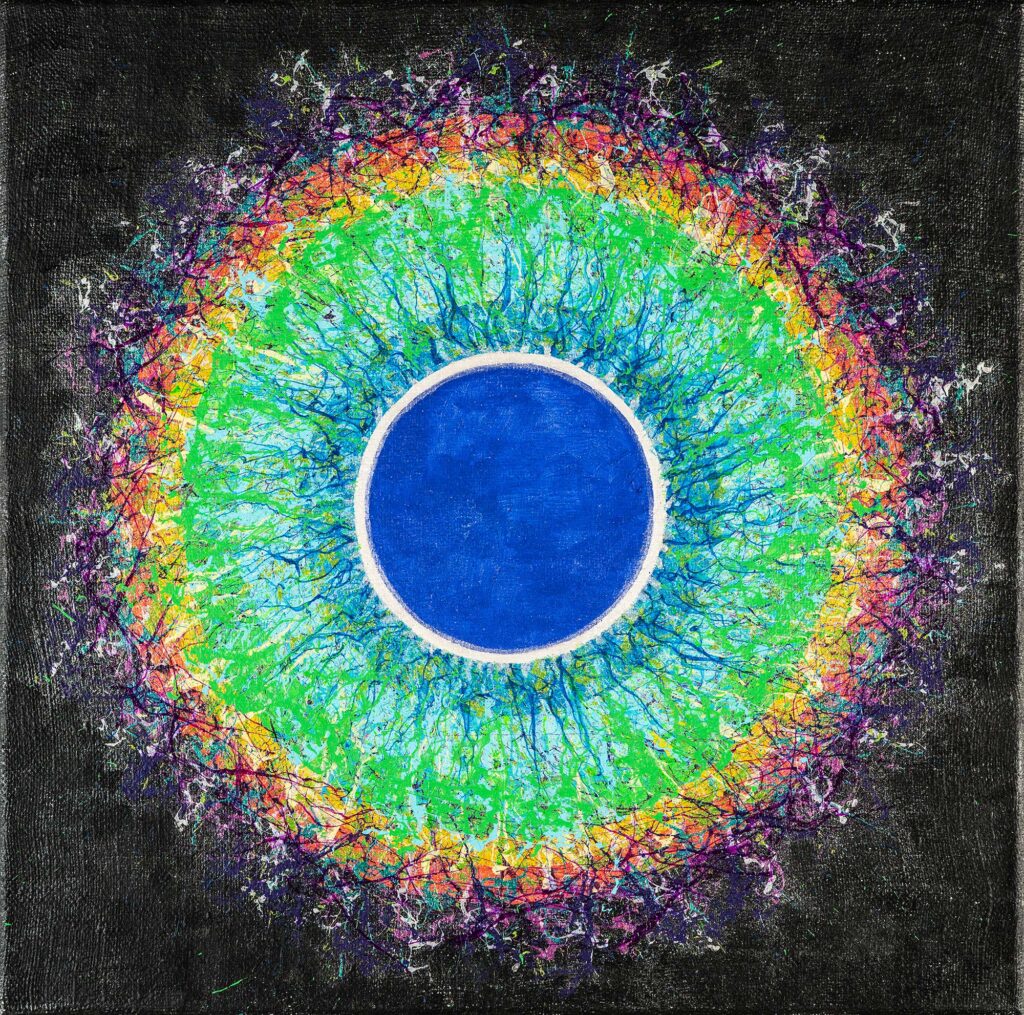
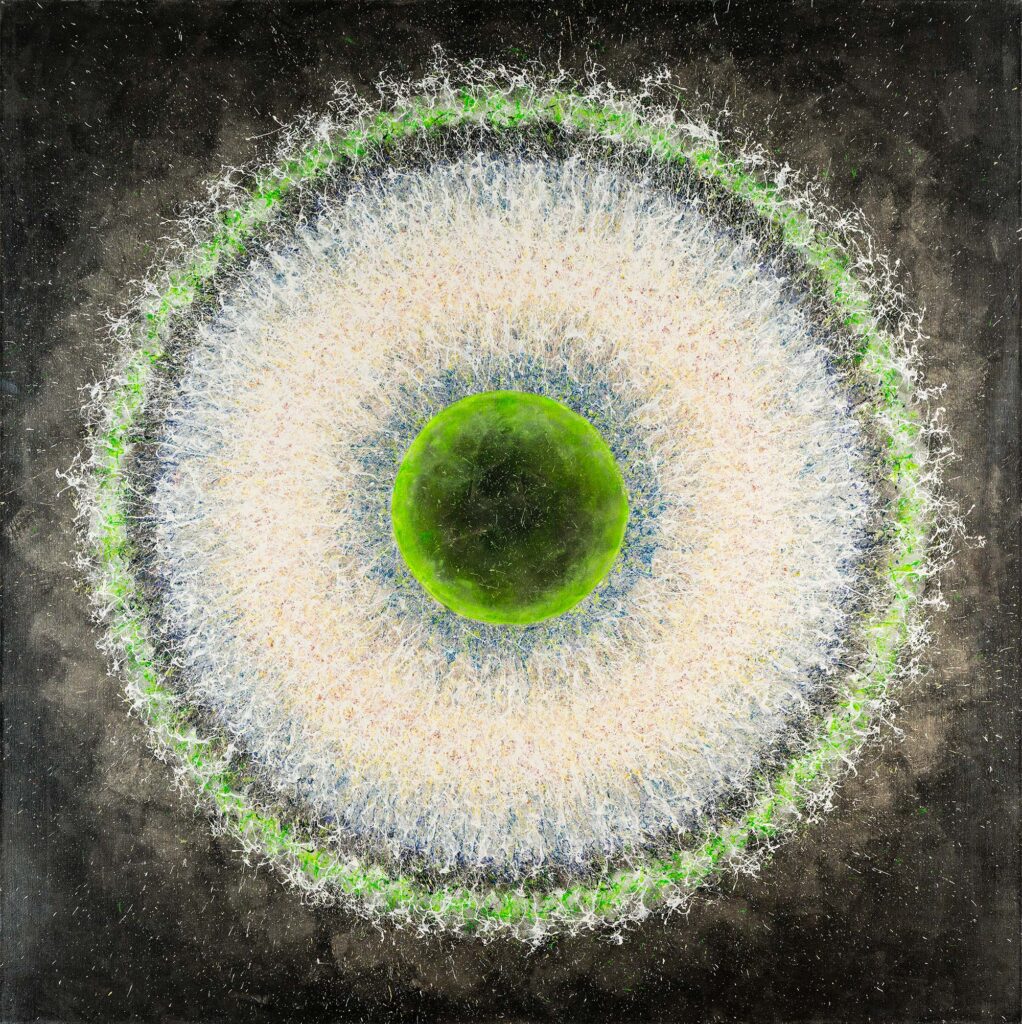
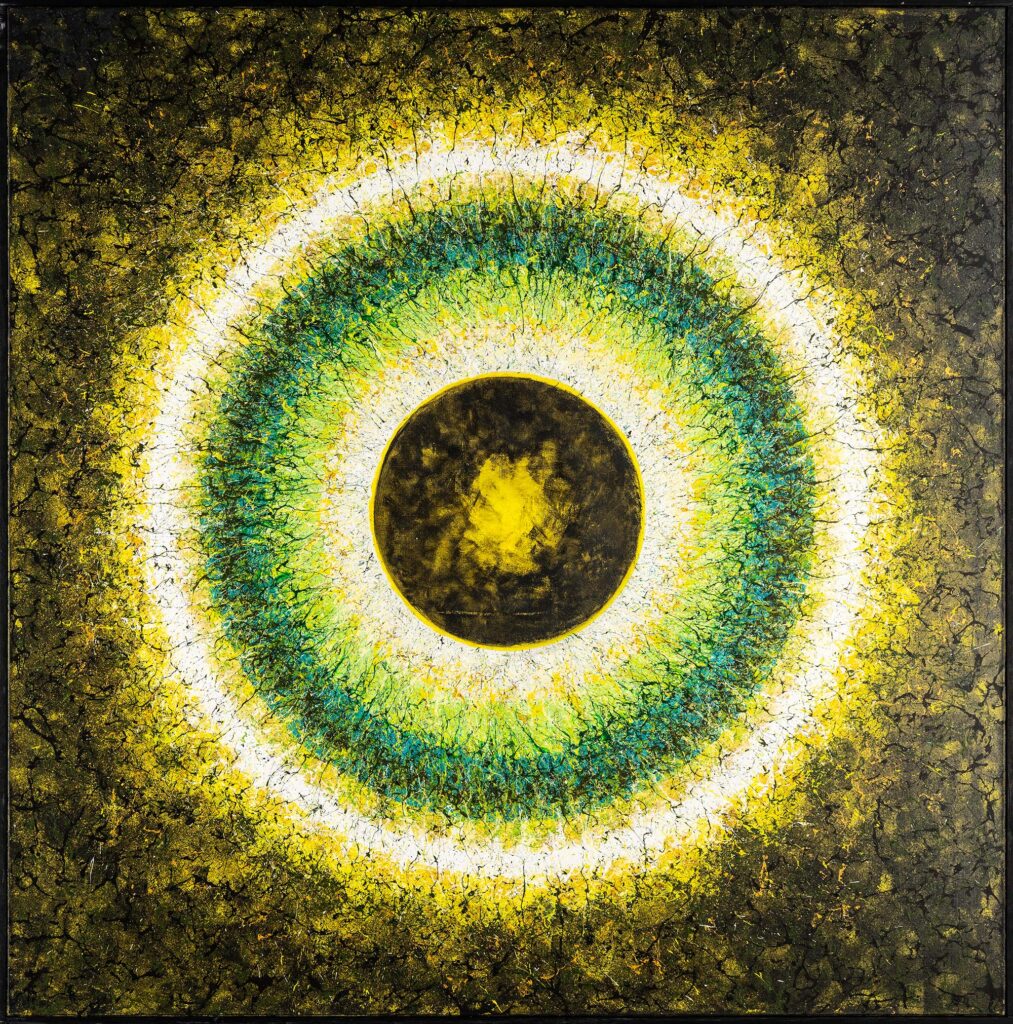
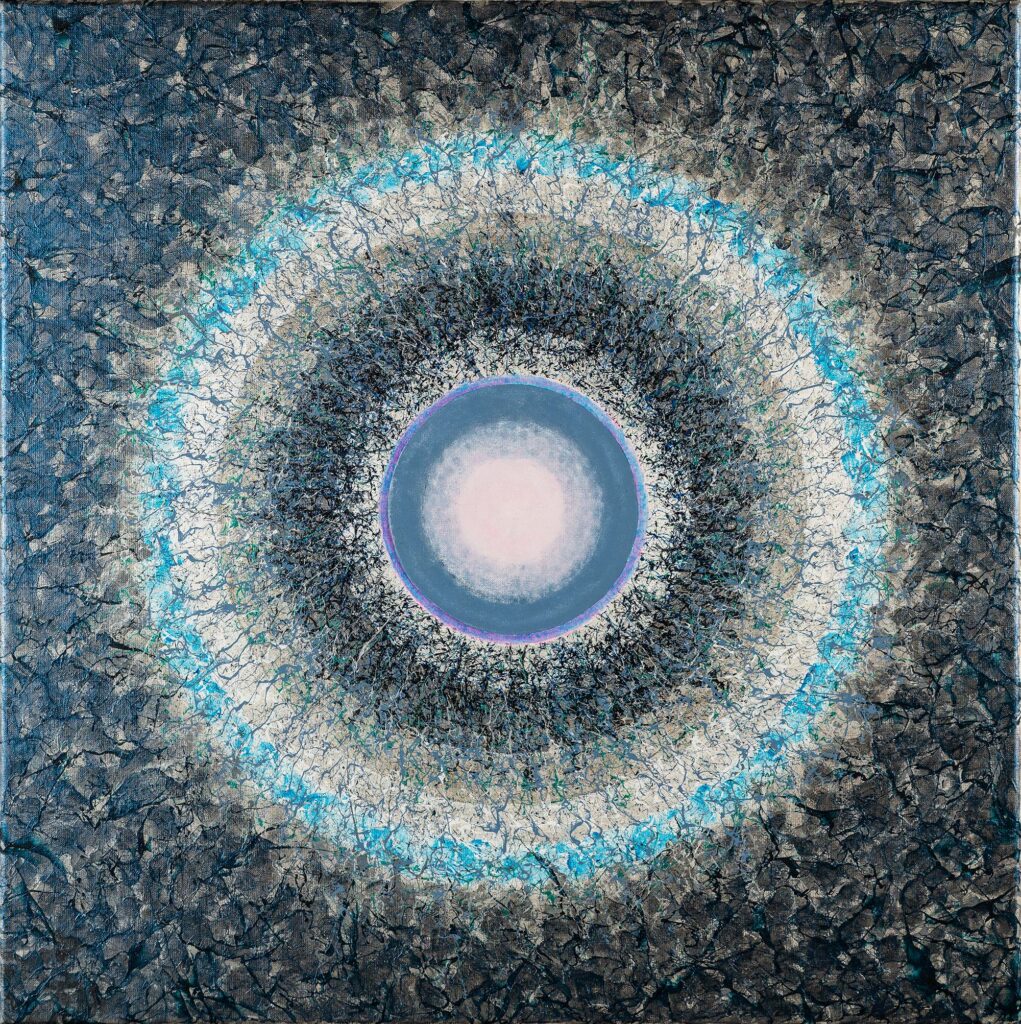


It took many years to conceive the idea of creating a series under the conventional title “Epicentre”.
Through various forms and slightly changing assumptions, appearing with the passage of time and the intensive process of creating my new artistic stage, this cycle has been changing its structure.
From the initial chaos symbolizing the cosmic disorder, to the extreme discipline of the form, assuming the shape of geometric symmetrical figures, the most perfect archetype of which is a circle.
The first assumption was to show the destruction and at the same time the transition from one form to another. The moment of the supernova explosion and the enormous energy released during this process. One could say by observing this phenomenon from a great distance – the beautiful death of a star.
Using the means of painting, I wish to show a phenomenon not only physical but also metaphysical. The symbolic display of the phenomenon of continuity and indissolubility of two elements – spirit and matter. The energy released during the explosion, scattering stardust in space, creating the seed of new life, new beings, is constant and is the driving force of all change.
My aspiration is to draw the viewer inside the painting by focusing their attention on its central point, so that they can feel the vibrations of energy and make them want to delve into and look no longer at the centre of the phenomenon, but at its epicentre.
It is about crossing the border between the material world and the world of feelings and intuition. The point is to think and feel deeper into what is just under the effective and violent process of destruction, to cause and effect. To the very meaning of changing life into death, and this, in turn, into another form of further existence. Therefore, my assumption is to focus not on the centre of the phenomenon, but rather – explicitly and unconditionally on its “EPICENTRE”. For what is the immediate cause of the change from one form to another. Looking at this point which is imperceptible and unconscious for the viewer, and which is the zone of the greatest concentration of energy. It reveals and symbolizes the whole sense of change and transformation – this Iconic Epicentre of limitless importance, is the subject of my creative experiments.
Inspiration with this philosophy resulted in the creation of a concept for the title of this comprehensive series.
It is also my intention to show how much energy can be released in a limited and simplest form, which is a circle. It would seem that a geometric figure is a stable, unshakable form, limited by its edges, unambiguously outlined. However, each figure, through its marking, is detached from the ground and someone’s will from which it was created, what also resulted in a certain charge of energy. Filling this form with colour, further intensifies this energy. Adding paint to this directional position builds up the tension and makes the assumed geometric figure, strictly defined, unshakable to live its own life.
It causes that the boundaries of this figure are no longer clearly defined and merge again with the surroundings from which it was created. It is like trying to show the pulsating transition of forms. I used here the assumptions and philosophy of the precursor of modern art and the founder of the trend known as Suprematism by Kazimierz Malewicz. Limiting the surface to geometric figures filled with colour. The most outstanding example of this is his Black Square, setting new directions and opening new fields of exploration, which constitute the foundation of a new philosophy of contemporary art.
The second idea for the technical construction of my paintings was inspired by the works of Jackson Pollock, where through a random, statistically unpredictable placement of paint on the canvas, he builds his own, despite everything, an extremely ordered world.
Another important assumption, on which the creation of my works of art is based, is to show the duality of nature. The human nature and nature in general. Just as there is good and evil, light and dark, spirit and matter, each of my paintings from the Quantum Epicentre series has two different faces. One of them is visible in a day light, but the other can only be seen when illuminated with ultraviolet light. In this case, the idea of creating the paintings was inspired by Planck’s philosophy, destroying the traditional theory of the wave structure of light radiation in favour of its quantum character. Or rather, an introduction to the physics of the concept of chaos theory. Hence the second part of the name of the series of my works, Quantum, which in a very simplified manner, could be called Radioactive Works.
Jaremi Picz
jaremi.picz@gmail.com
+48 502 103 391
Opole